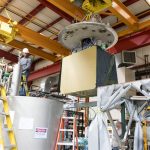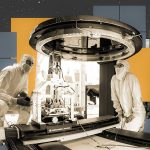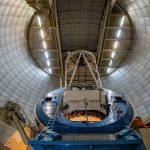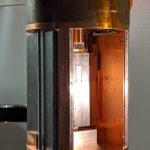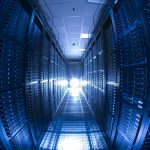From NIST, Oct. 13, 2020: Researchers at NIST and their colleagues, including Fermilab scientist Gordan Krnjaic, have proposed a novel method for finding dark matter. The experiment, in which a billion millimeter-sized pendulums would act as dark matter sensors, would be the first to hunt for dark matter solely through its gravitational interaction with visible matter. A three-minute animation illustrates the new technique.
detector technology
Scientists are testing the components and systems for the international Deep Underground Neutrino Experiment, hosted by Fermilab, with other liquid-argon particle detectors. One such detector is ICEBERG, which is over 10,000 times smaller than DUNE will be. ICEBERG’s measurements are providing insight for future neutrino experiments.
From Página 12, Sept. 12, 2020: Recibió el reconocimiento “Nuevos Horizontes en Física 2021” en el marco de los premios Breakthrough. Se recibió en la UBA y desde hace años investiga en el Fermilab de Chicago, el laboratorio de física de partículas más importante de Estados Unidos.
Sensors for the world’s largest digital camera have snapped their first 3,200-megapixel images at SLAC. Crews at the SLAC National Accelerator Laboratory took the photo with an extraordinary array of imaging sensors that will become the heart and soul of the future camera of Vera C. Rubin Observatory.
Scientists have begun operating the Dark Energy Spectroscopic Instrument, or DESI, to create a 3-D map of over 30 million galaxies and quasars that will help them understand the nature of dark energy. The new instrument is the most advanced of its kind, with 5,000 robotic positioners that will enable scientists to gather more than 20 times more data than previous surveys. Researchers at Fermilab helped develop the software that will direct these positioners to focus on galaxies several billion light-years away and are currently in the process of fine-tuning the programs used before the last round of testing later this year.
The detector for the international Deep Underground Neutrino Experiment will collect massive amounts of data from star-born and terrestrial neutrinos. A single supernova burst could provide as much as 100 terabytes of data. A worldwide network of computers will provide the infrastructure and bandwidth to help store and analyze it. Using artificial intelligence and machine learning, scientists are writing software to mine the data – to better understand supernovae and the evolution of our universe.
From INFN, April 9, 2020: L’industria di solito non utilizza l’elettronica che opera a temperature criogeniche, perciò i fisici delle particelle hanno dovuto costruirsela da sé. Una collaborazione tra numerosi laboratori nazionali afferenti al Dipartimento dell’Energia, incluso il Fermilab, ha sviluppato prototipi dell’elettronica che verrà alla fine utilizzata nell’esperimento internazionale DUNE – Deep Underground Neutrino Experiment, ospitato dal Fermilab.

